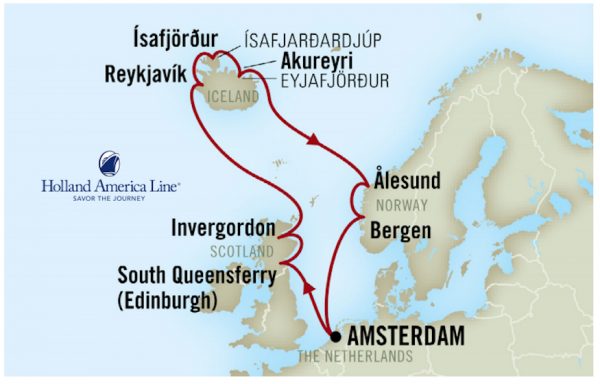 Explore lands of fire and ice with renowned scientists, Drs. Glenn Starkman and Patricia Princehouse, August 6 – 20, 2017 while on board the majestic Holland America Line’s Koningsdam. Full details about shipboard accommodations and amenities, as well as an itinerary, may be found in the ISO Cruise Brochure.
Explore lands of fire and ice with renowned scientists, Drs. Glenn Starkman and Patricia Princehouse, August 6 – 20, 2017 while on board the majestic Holland America Line’s Koningsdam. Full details about shipboard accommodations and amenities, as well as an itinerary, may be found in the ISO Cruise Brochure.
Aboard ship, get the latest thinking on the origins of the universe, and of life; evolution; particle physics; and gravitational waves. In port, sample the refinement and ruggedness of Edinburgh and the atmospheric beauty of the Scottish Highlands. Visit the meeting of tectonic plates, spectacular waterfalls, and geothermal delights in Iceland’s countryside, and chat with friendly Icelanders. Absorb Art Nouveau and medieval architecture and venture into Norway’s fjords.
The classes to be lead by Drs. Starkman [S] and Princehouse [P] include these tantalizing titles:
- [S] The Standard Model of Particle Physics: From Atoms to Quarks- Matter is made out of atoms, but what are atoms made of? Answering that question has taken us from experiments that we can do today in undergraduate teaching laboratories to the construction of the Large Hadron Collider in Geneva — the largest machine in the world. In the process, scientists have come to understand the Standard Model of particle physics, the single best-tested theory in all of science.
- [P] Darwin: The Man and his Theory- Darwin’s time in Edinburgh was fraught with emotional upheaval
 and intellectual exhilaration as on one hand the 16-year-old discovered and named a new species he collected from the sea and on the other he made the momentous decision not to go into medicine as a profession. Join Dr. Princehouse as we explore the surprising ways in which these events led to crucial elements of Darwin’s theory of evolution that endure in science today.
and intellectual exhilaration as on one hand the 16-year-old discovered and named a new species he collected from the sea and on the other he made the momentous decision not to go into medicine as a profession. Join Dr. Princehouse as we explore the surprising ways in which these events led to crucial elements of Darwin’s theory of evolution that endure in science today. - [S] Do We Need More than the Standard Model of Particle Physics? The Standard Model is amazingly successful at describing the interactions of fundamental particles. Once we include in it mass for neutrinos, it gets everything we know about particle physics right. And yet … for decades most particle physicists have believed that the Standard Model is only part of the story — that it has problems that must be fixed. What are those problems? How have physicists thought to fix them? Are we sure they are problems at all?
- [P] Human Evolution: the first 500 million years! How are humans related to the rest of the natural world? Come follow the twists and turns animal evolution has taken across the phanerozoic eon to produce the amazing diversity of animal life we find all around us today –including ourselves!
- [S] So What are These Gravitational Waves, and Why Should I Care About Them? On February 11th 2016 members of the LIGO collaboration announced to the world the first direct detection of gravitational waves, generated, they claimed, by a pair of massive black holes spiraling toward one another and then merging over one billion years ago. What’s a gravitational wave? Why has it taken us 100 years to see them? And what’s the big deal anyway?
- [P] The Evolution of Domestic Animals- Breeds of domestic animals are biological vestiges of cultural history. Over the past 30,000 years human cultures have knowingly and unwittingly created unique niches which certain species have readily filled –following the same basic evolutionary processes as wild species. Just as we find dwarf elephants and deer on islands, we find small ponies, sheep and dogs on the Shetland isles. Biologists are learning about evolution in natural populations by studying traditional domestic breeds. But these heirloom breeds are rapidly disappearing –which also parallels the disappearance of natural habitats around the globe.
- [S] The State of the Universe Report- The Universe is big, and getting bigger at an accelerating rate. How big? how fast? How do we know? Join Dr. Starkman and hear the latest thought on Cosmic Microwave Background Radiation and other phenomena that give us information on the early universe, spacetime expansion, the large scale structure of the universe.
- [P] Extreme Evolution- The polar seas are home to a stunning array of unusual animals with unique adaptations such as icefish whose blood contains an antifreeze solution they make within their bodies. Weird organisms eke out an existence deep within hot springs. How do such quirks, oddities and anomalies evolve? How can the blind process of natural selection produce such successful adaptations?
